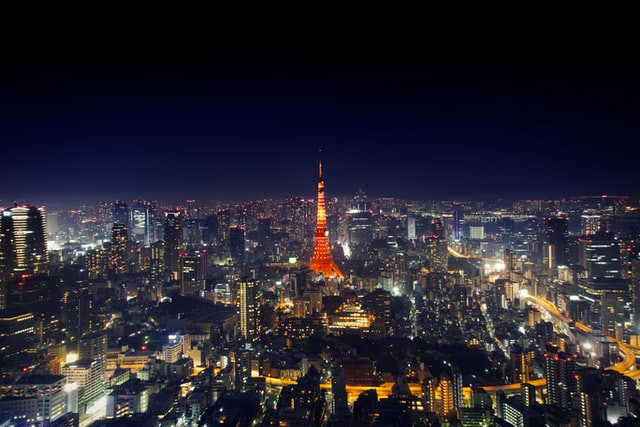An iconic symbol of the Japanese resilience and engineering, the Tokyo Tower stands proudly at the height of 332.9 meters. For over 50 years, the Tokyo Tower held the title of the tallest tower in Japan only surpassed by the newer Tokyo Skytree. As of now, it still is among the tallest in the world.
History
A brief history of the Tokyo Tower
Due to the start of television broadcasting in Japan in 1953, an enormous broadcasting tower was necessary after NHK, Japan's public broadcasting station, began airing televised broadcasting. Construction of broadcasting towers by private entities also started on the assumption that having various transmission sites would overwhelm all of Tokyo. This led to the proposal of building one large transmission tower capable of accommodating all broadcast from the entire region, thus Tokyo Tower (Japan Radio Tower) was built.
At 333.9 meters (1,092 ft.), it is the second tallest observation tower in Japan second only to the celebrated SkyTree of Japan. It officially opened to the world on December 23, 1958. This incredible engineering feat cost ¥ 2.8 billion, which is equivalent to US $8.4 million at that time.
For years, it was the tallest freestanding tower surpassing the Eiffel tower by nine meters and stealing its title until Tokyo Skytree surpassed it in 2010, indeed, a giant symbolic step towards revival. Tokyo Tower became a symbol of Japan's post-war renaissance, becoming one of the world's major economic powers.
※International Herald Tribune, "Tokyo Tower goes from futuristic hope to symbol of the good old days"
Origins and Inspiration of the design

The ingenious design of the tallest freestanding tower in the world, inspired by the Eiffel Tower, was credited to Tachu Naito, one of the leading infrastructural designers in Japan at that time. Originally, Hisakichi Maeda, president of Nippon Denpatō, wanted the Tokyo Tower to surpass the height of the Empire State Building in New York, which didn’t end up working out. Naito asserted that the design of the tower would withstand huge earthquakes and strong typhoons, disasters Tokyo is prone to face.
Retirement of the initial tower responsibilities
Initially, the tower served as a transmission tower throughout the Tokyo region, serving both televised and radio broadcasts. However, due to its fascinating structure and incredible height, the tower became a man-made attraction, alluring both the locals and tourists. Through time, Tokyo Tower became a broadcasting tower serving Tokyo City while also gaining revenue as an infamous tourist attraction.
Writer's Pick
Significance
Functions of the Tokyo Tower
Tokyo Tower operates as a radio and television broadcasting antenna support structure and is also a rendezvous point of tourists all around the globe, housing numerous different attractions. Initially, the tower was built for televised broadcast, but later on, it was also installed with a radio antenna to accommodate radio broadcast benefitting various organizations for transmission purposes.

Different sections of the tower
The tower's main deck is at 150 meters reached by elevator. Due to the tower's geographic location, a view from the observatory should amaze anyone of the fascinating beauty of the city. There are also "look down" windows on the floor to stand on, a souvenir shop, and a café from which locals and tourists could venture to.
The second set of elevators will take you to the 250-meter-high top deck from where you can get an overall picture of Tokyo City from high above. For tourists to enjoy their visit, it is recommended to stopover on fair weather to visibly see the Tokyo Skytree and the Mt. Fuji from the observation deck.
At the base of the tower is the "Foot Town" building, which contains a variety of gift shops, cafes, restaurants, and the One Piece Tower, a manga themed indoor amusement park.
Nearby places to visit
Foot Town
Foot Town is the name for a 4-story building at the base of the tower because first, it is in the foot of the Tokyo Tower, and second, it is huge enough to serve a multitude of interested tourists and locals, thus like a town. Foot Town has an Aquarium Gallery, reception hall, a 400-person-capacity "Tower Restaurant" on the first floor. The second floor is basically for food and shopping, including five standalone restaurants and a food court including the likes of McDonald's and Pizza La. The third floor highlights the Guinness World Records Museum Tokyo, featuring notable records that have been validated by the Guinness Book. A small amusement park is set at the roof of the Foot Town that includes short rides for children and live performances.
One Piece Tower
Tokyo Tower features a themed amusement park from Eiichiro Oda's manga One Piece. The One Piece Tower is an indoor amusement park that is a must-see, especially if you are a fan of the series. Tourists and locals can enjoy various games and attractions based on their favorite characters and enjoy meals from the One Piece world. There is also a gift shop that highlights exclusive souvenir items for the huge fans of the manga.
Zojoji Temple

This temple next to Tokyo Tower is the main sanctuary of the Jodo faction of Japanese Buddhism. Housing a small museum, as well as a mausoleum, is a site with plenty of history. Located beside the titanic Tokyo Tower, the temple houses fascinating and impressive structures and artifacts of the Tokugawa family as well as the tombs of six Tokugawa shogun. Most of the buildings are new reconstructions except for the gate which as withstood many disasters and the like since 1622.
Summary

Being among the top attractions visited by locals as well as tourists in Tokyo, Tokyo Tower earned its place as one of the highest revenue collectors as a tourist attraction. Tokyo Tower had come a long way from being the second tallest tower in Japan to being one of the fascinating man-made wonders, captivating various people around the world. It is a symbol of renaissance, power, and unity.








.jpg)




















